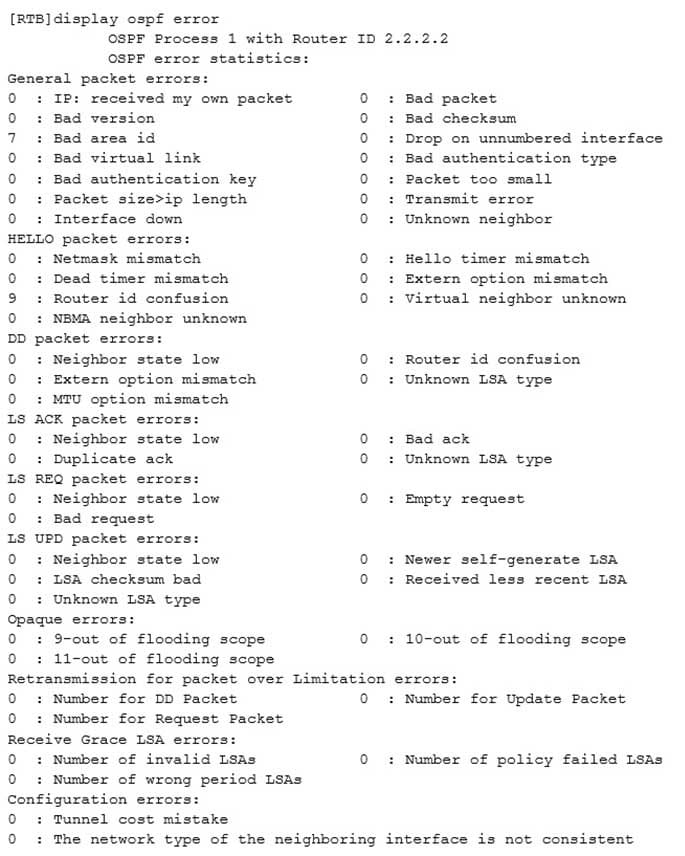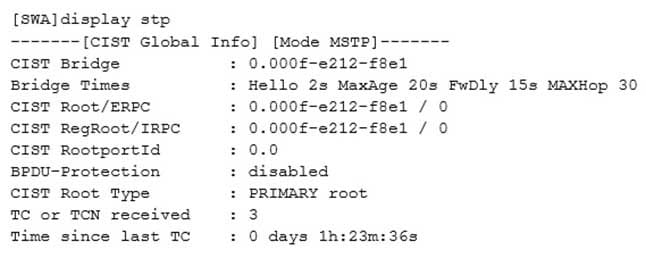H12-224 : HCNP-R&S Fast Track (Huawei Certified Network Professional – Routing & Switching Fast Track) : Part 11
-
You cannot set an aging time for the blacklist of the Eudemon.
- True
- False
-
Which of the following packet drop policies can be applied to the congestion avoidance mechanism? (Choose three.)
- Tail-drop
- RED
- WRED
- WFQ
-
When recovering from a fault, the active link in a Smart Link group remains blocked and traffic is not switched back to it. In this way, traffic keeps stable.
- True
- False
-
RTA connected to a LAN by e0/0 whose IP address is 10.1.1.251 and network Mask is 255.255.255.0. Now create a virtual router with ID 1 and virtual IP address 10.1.1.254 on RTA. Which of the following commands are correct?
- [RTA-Ethernet0/0]vrrpvrid 1 virtual-ip 10.1.1.254
- [RTA]vrrpvrid 1 virtual-ip 10.1.1.254
- [RTA-Ethernet0/0]vrrpvrid 1 virtual-ip 10.1.1.254 mask 255.255.255.0
- [RTA]vrrpvrid 1 virtual-ip 10.1.1.254 mask 255.255.255.0
-
To provide services of different qualities, you can classify services based on such packet information as the packet priority, source IP address, destination IP address, and port number. Which of the following QoS technology can be used to service classification?
- Traffic policing
- Traffic shaping
- Complex traffic classification
- Congestion management
-
Which of the following statements about different detection intervals at both ends of a BFD session is true?
- The BFD session can be set up and the greater detection interval is used after negotiation.
- The BFD session can be set up and the smaller detection interval is used after negotiation.
- The BFD session can be set up and each end sends detection packets at its own interval.
- The BFD session cannot be set up.
-
By using VRRP, the backup router in a VRRP backup group immediately becomes the master router after detecting a fault and instructs its attached hosts to perform a master/slave switchover accordingly. This ensures that services will recover within a short period of time.
- True
- False
-
Assume that the VRID of a VRRP virtual router is 100 and the virtual IP address of the virtual router is 192.168.1.1, which of the following addresses is the virtual MAC address of the virtual router?
- 00-00-5E-00-01-64
- 00-00-5E-00-01-01
- 01-00-5E-00-01-64
- 01-00-5E-00-01-01
-
Which of the following are popular link efficiency mechanisms? (Choose two.)
- IPHC
- LFI
- HDLC
- PPP
-
In traffic policing using two token buckets, tokens are put into the CBS bucket at the committed information rate (CIR).

H12-224 HCNP-R&S Fast Track (Huawei Certified Network Professional – Routing & Switching Fast Track) Part 11 Q10 013 The peak burst size (PBS) bucket is filled in only after the CBS bucket is full.
- True
- False
-
Which of the following authentication modes does VRRP use? (Choose three.)
- No authentication
- Simple text password
- MD5
- CHAP
-
Which of the following addresses is the destination address of VRRP packets?
- 224.0.0.18
- 224.0.0.19
- 224.0.1.18
- 224.0.1.19
-
A BFD session is set up following the three-way handshake during which parameters for the BFD session are negotiated. After the BFD session is set up, modifying the detection time parameters does not take effect.
- True
- False
-
Which of the following statements about traffic policing are true? (Choose three.)
- Is used to limit the traffic transmission rate.
- Is used to color packets.
- Caches packets whose transmission rate exceeds the limit.
- Re-marks packets with priorities.
-
Which of the following statements are correct regarding Master in VRRP? (Choose two.)

H12-224 HCNP-R&S Fast Track (Huawei Certified Network Professional – Routing & Switching Fast Track) Part 11 Q15 014 - The router with highest priority will become Master.
- The router with smallest priority will become Slave.
- The router with highest priority may not always be Master.
- The router with smallest priority may not always be Slave.
-
Assume that there are four flows a, b, c, and d, the transmission rate of each flow is 50 Mbit/s, and the total bandwidth of the interface for flow transmission is 100 Mbit/s. In the case of congestion, WFQ is available for flows a, b, c, and d, with the weight proportion being 1:2:3:4. Which of the following statement about the interface bandwidth allocated to each flow is true?
- Interface bandwidths allocated to flows a, b, c, and d are 10 Mbit/s, 20 Mbit/s, 30 Mbit/s, and 40 Mbit/s respectively.
- Interface bandwidths allocated to flows a, b, c, and d are 50 Mbit/s, 50 Mbit/s, 0 Mbit/s, and 0 Mbit/s respectively.
- Interface bandwidths allocated to flows a, b, c, and d are 40 Mbit/s, 30 Mbit/s, 20 Mbit/s, and 10 Mbit/s respectively.
- Flows a, b, c, and d are discarded.
-
Which of the following are factors that affect QoS? (Choose three.)
- Bandwidth
- Cost
- Jitter
- Loss of packet
-
Which of the following statements are correct regarding MAC address of VRRP packet?
(Choose two.)
H12-224 HCNP-R&S Fast Track (Huawei Certified Network Professional – Routing & Switching Fast Track) Part 11 Q18 015 - The destination MAC is broadcast MAC address.
- The destination MAC is multicast MAC address.
- The source address is virtual MAC address.
- The source address is physical MAC address of Master.
-
Which of the following statements about the refreshing mechanism in the case of link switchover in a Smart Link group is false?
- MAC and ARP entries are refreshed automatically against traffic.
- The Smart Link group uses a new link to send Flush packets.
- When the active link recovers from a fault, Flush packets are sent to refresh entries.
- When recovering from a fault, the active link remains blocked and traffic is not switched back to it. In this way, traffic keeps stable.
-
Assume that the WRED policy for packets with the priority of AF21 is that the length of the queue for saving packets ranges from 35 to 40, and the discarding percentage is 50%. When a packet with the priority being AF21 arrives, which of the following statements are true? (Choose three.)
- If the average length of the queue is smaller than 35, the packet is added to the queue.
- If the length of the queue ranges between 35 and 40, the packet may be discarded with a possibility of 50%.
- If the average length of the queue is greater than 40, the packet is added to the queue.
- If the average length of the queue is greater than 40, the packet is discarded.
Subscribe
0 Comments
Newest